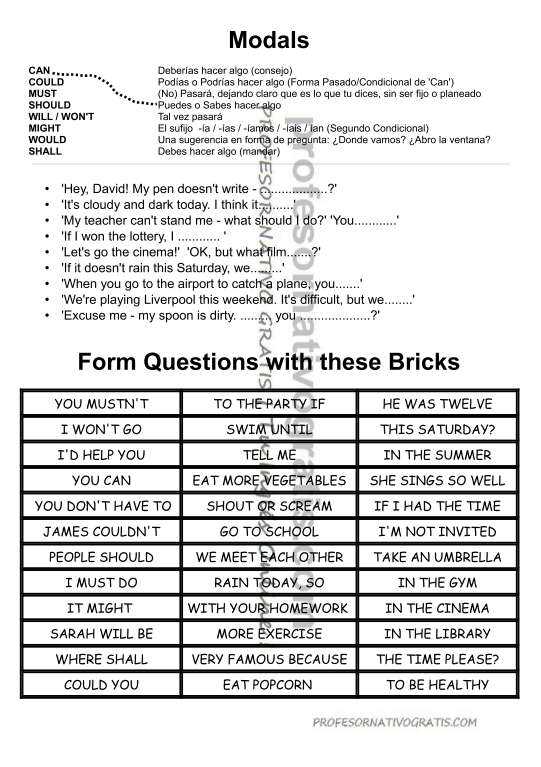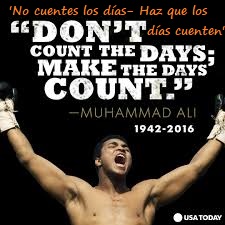ARE YOU A TEACHER? WOULD YOU LIKE TO USE THIS ACTIVITY FOR YOUR CLASS? CLICK HERE TO DOWNLOAD THE PDF.
Instructions
Students will have to have some knowledge of Modal Verbs to be able to do this exercise.
1. FIRST SECTION
If you are not a teacher in a Spanish-speaking country – or prefer to use English only in class – cut out this part of the page.
Give your students 3 minutes to join the Modal Verbs with their definitions. Go around the class and see how well they are doing, without helping. This gives you the opportunity to see how well your students know the Modals, so you can explain and clarify, where necessary.
Tell students to give their answers, together with examples.
2. SECOND SECTION
Depending on the size of your class you can do this directly as a speaking activity, or in bigger classes get the students to form pairs and complete the sentences using the Modals. Explain that they can repeat, but that each Modal must be used at least once.
Suggestions:
Hey David. My pen doesn’t write – CAN YOU lend me one? CAN I borrow yours? (‘Could’ is too formal)
It’s cloudy and dark today. I think it WILL / MIGHT /COULD rain.
My teacher can’t stand me. What should I do? You SHOULD / COULD talk to him or her.
If I won the lottery, I WOULD study in England.
Let’s go the cinema. OK, but what film SHALL we see?
If it doesn’t rain this Saturday, we WILL / MIGHT / COULD / CAN go to the beach.
When you go to the airport to catch a plane, you MUST show your passport.
We’re playing Liverpool this weekend. It’s difficult, but we WILL / MIGHT / COULD / CAN win.
Excuse me – my spoon is dirty. COULD you change it for me, please?
Notes:
I have not included ‘OUGHT TO’ (= SHOULD) or MAY (= COULD, more formal way of asking for permission, and more formal version of MIGHT). You do not have to mention this if you want to keep things (relatively) simple, but for the sake of the next exercise, you should make sure the students know the difference between MUSTN’T and DON’T HAVE TO. You can use these sentences as an example, and ask somebody to explain the difference:
You mustn’t do what your friends tell you.
You don’t have to do what your friends tell you.
You may have to explain or remind them of the second conditional: That you have to use the Subjunctive (= Past Simple) in the other part of a ‘Would’ sentence, and the ‘-‘D’ contraction.
3. THIRD SECTION
Get the students (individually or in pairs) to cut out the 36 squares, making sure they separate the beginning, middle and end of the sentences in 3 piles, as it is on the list. This should take 5 minutes. Then they have to form 12 correct sentences. There is only solution – there can be many possibilities on any one sentence, but only one way to combine all twelve:
YOU MUSTN’T SHOUT OR SCREAM IN THE LIBRARY
I WON’T GO TO THE PARTY IF I’M NOT INVITED
JAMES COULDN’T SWIM UNTIL HE WAS TWELVE
I’D HELP YOU WITH YOUR HOMEWORK IF I HAD THE TIME
YOU CAN EAT POPCORN IN THE CINEMA
YOU DON’T HAVE TO GO TO SCHOOL IN THE SUMMER
PEOPLE SHOULD EAT MORE VEGETABLES TO BE HEALTHY
WHERE SHALL WE MEET EACH OTHER THIS SATURDAY?
I MUST DO MORE EXERCISE IN THE GYM
IT MIGHT RAIN TODAY, SO TAKE AN UMBRELLA
SARAH WILL BE VERY FAMOUS BECAUSE SHE SINGS SO WELL
COULD YOU TELL ME THE TIME PLEASE?
Feel free to leave any comments, and share the news with other teachers!







Leave a Reply